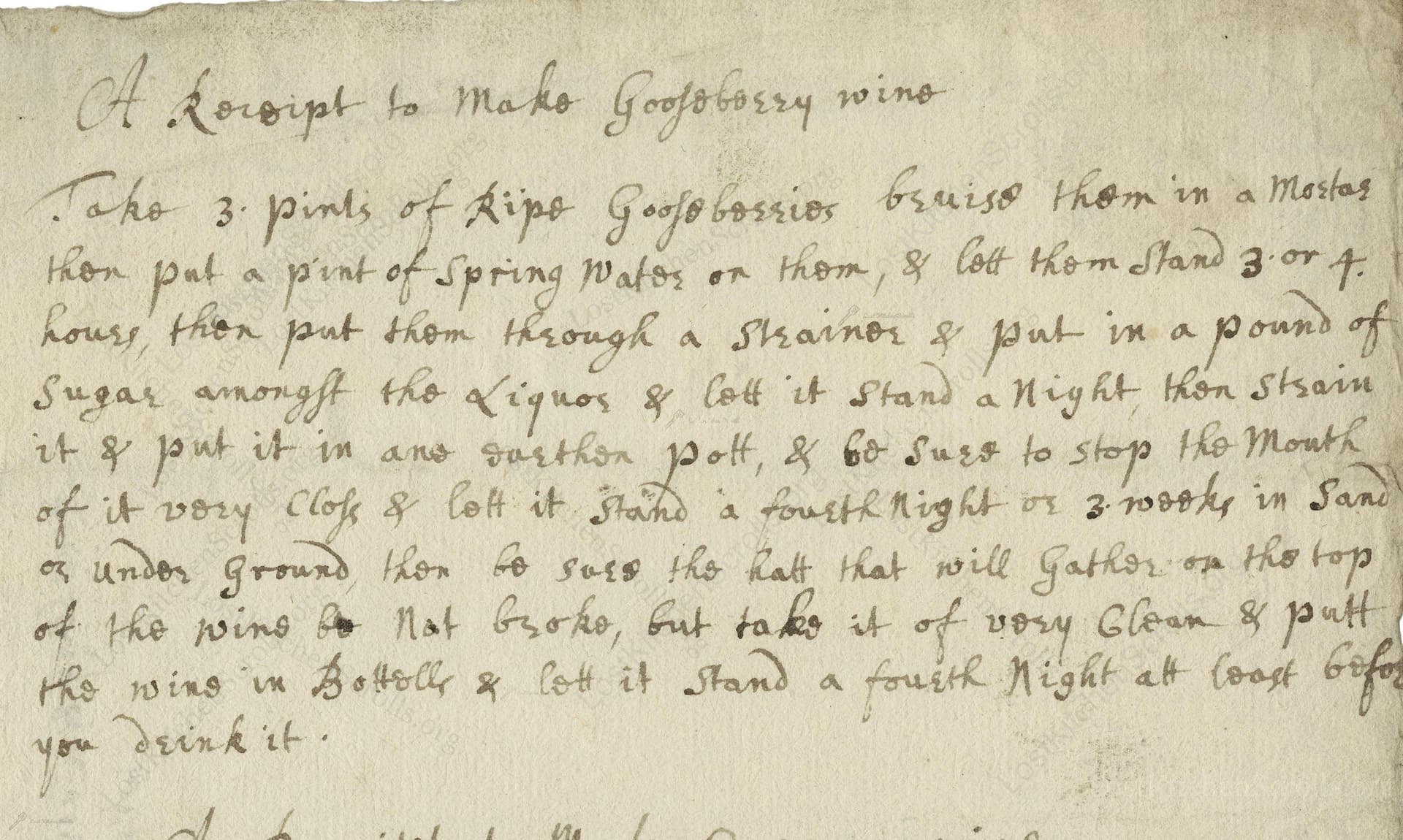A Receipe To Make Gooseberry Wine
From the treasured pages of Receipt for making gooseberry and currant wine
Unknown Author

A Receipe To Make Gooseberry Wine
"Take 3 pints of Ripe Gooseberries bruise them in a Mortar then put a pint of Spring Water on them, & lett them stand 3 or 4 hours, then put them through a strainor & put in a pound of Sugar amongst the Liquor & lett it stand a Night then strain it & put it in ane earthen pott, & so suss to stop the Mouth of it very Close & lett it stand a fourth Night or 3 weeks in Sand or under ground then so suss the Rest that will gather on the top of the wine be Not broke, but take it of very Clean & putt the wine in Bottels & lett it stand a fourth Night at least before you drink it."
Note on the Original Text
The original recipe is written in the spelling and syntax of late 17th-century English, with fluid grammar and variable punctuation—'lett' for 'let', 'strainor' for 'strainer', 'pott' for 'pot', and 'suss' an unclear term likely meaning 'ensure' or instructing not to disturb the sediment. Measurements are in pints and pounds, common domestic units of the time. The text reflects oral instructions transferred to paper for memory, typical before precise culinary prose became standard.

Title
Receipt for making gooseberry and currant wine (1690)
You can also click the book image above to peruse the original tome
Writer
Unknown
Era
1690
Publisher
Unknown
Background
Step back into the lavish banqueting halls of the late 17th century and savor a delightful array of recipes and kitchen secrets from a time when culinary artistry knew no bounds.
Kindly made available by
Folger Shakespeare Library
This recipe comes from around 1690, a period when British cooks and households experimented with fermenting fruits to create home-born wines before grape wine became widespread. Gooseberries, abundant in English gardens, provided a tart, refreshing base for these domestic beverages. Such recipes reflect the resourcefulness and culinary creativity of early modern households, where preservation and fermentation were both necessity and art. The manuscript reference 'X.d.745' indicates it comes from a collection of handwritten domestic manuscripts, pointing to the everyday nature of such kitchen adventures among literate women or household stewards.

In the 17th century, kitchen work relied on sturdy, manual utensils. Here, a mortar and pestle would be essential for crushing the gooseberries, and the straining would be done through a fine linen cloth or muslin set over a bowl. Earthenware pots, sealed with waxed fabric or cork, served as fermentation vessels. The pots might be half-buried in sand or stored in cellars to maintain a stable, cool temperature, preventing spoilage during the fermenting period.
Prep Time
30 mins
Cook Time
0 mins
Servings
8
We've done our best to adapt this historical recipe for modern kitchens, but some details may still need refinement. We warmly welcome feedback from fellow cooks and culinary historians — your insights support the entire community!
Ingredients
- 3.3 lb ripe gooseberries (fresh or substitute with green/red currants if unavailable)
- 1 pint (1 1/5 cups) spring water (or filtered water)
- 1 lb white granulated sugar
Instructions
- Take 3.3 lb of ripe gooseberries and crush them gently in a large bowl (or with a potato masher if you don't have a mortar).
- Add 1 pint (1 1/5 cups) of fresh spring water, stir, and let the mixture sit for 3–4 hours to macerate.
- Strain the mixture through a fine mesh sieve or muslin cloth, collecting all the juice.
- For each 1 pint (1 1/5 cups) of juice, add 1 lb of granulated sugar and stir until dissolved.
- Cover the mixture and let it stand overnight at cool room temperature.
- Strain again to remove any remaining solids.
- Transfer the liquid to a ceramic or glass fermenting jar, seal tightly (an airlock is helpful if you have one), and let it ferment for 10–21 days (historically in sand or underground, but anywhere cool and dark will do).
- Carefully skim off any sediment or film that forms on top, making sure not to disturb the clear wine.
- Decant into sterilized bottles and allow the wine to mature for at least another night before tasting, preferably longer for best flavor.
Estimated Calories
110 per serving
Cooking Estimates
Preparing this gooseberry wine takes about 30 minutes and includes crushing the berries and mixing with water. You then need to let it sit for a few hours and strain the juice, then add sugar and let it rest overnight. The fermentation process takes up to 21 days, but there is no actual cooking. Each serving of this wine has about 110 calories, and the recipe yields about 8 servings.
As noted above, we have made our best effort to translate and adapt this historical recipe for modern kitchens, taking into account ingredients nowadays, cooking techniques, measurements, and so on. However, historical recipes often contain assumptions that require interpretation.
We'd love for anyone to help improve these adaptations. Community contributions are highly welcome. If you have suggestions, corrections, or cooking tips based on your experience with this recipe, please share them below.
Join the Discussion
Rate This Recipe
Dietary Preference
Main Ingredients
Culinary Technique

Den Bockfisch In Einer Fleisch Suppen Zu Kochen
This recipe hails from a German manuscript cookbook compiled in 1696, a time whe...

Die Grieß Nudlen Zumachen
This recipe comes from a rather mysterious manuscript cookbook, penned anonymous...

Ein Boudain
This recipe comes from an anonymous German-language manuscript cookbook from 169...

Ein Gesaltzen Citroni
This recipe, dating from 1696, comes from an extensive anonymous German cookbook...
Browse our complete collection of time-honored recipes



